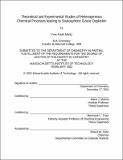| dc.contributor.advisor | Mario J. Molina and Bernhardt L. Trout. | en_US |
| dc.contributor.author | Mantz, Yves André, 1974- | en_US |
| dc.contributor.other | Massachusetts Institute of Technology. Dept. of Chemistry. | en_US |
| dc.date.accessioned | 2005-05-19T14:39:47Z | |
| dc.date.available | 2005-05-19T14:39:47Z | |
| dc.date.copyright | 2002 | en_US |
| dc.date.issued | 2002 | en_US |
| dc.identifier.uri | http://hdl.handle.net/1721.1/16806 | |
| dc.description | Thesis (Ph.D.)--Massachusetts Institute of Technology, Dept. of Chemistry, 2002. | en_US |
| dc.description | Vita. | en_US |
| dc.description | Includes bibliographical references. | en_US |
| dc.description | This electronic version was submitted by the student author. The certified thesis is available in the Institute Archives and Special Collections. | en_US |
| dc.description.abstract | The microscopic chemical mechanisms of heterogeneous reactions involving HC on crystalline ice and nitric acid trihydrate (NAT) are of fundamental interest to physical chemists, because such reactions yield "active" chlorine compounds that are readily photolyzed to yield radicals responsible for the annual destruction of polar stratospheric ozone. Using molecular-orbital and density-functional-based computational methods that are extensively validated, partial dissociation of HCl is shown to be kinetically rapid and thermodynamically favorable on an extended ice Ih surface model with two dangling OH groups in close proximity to adsorbed HCl at a binding site on the surface. Additionally, surface disordering of this ice model is observed at polar stratospheric temperatures when HCl is adsorbed at this site. The partial dissociation of HCl on/atop ice will compete with other proposed mechanisms only if the local density of surface dangling OH groups is high. This alternative mechanism of chlorine activation is not important on NAT, based on the theoretical study of HCl interacting with various low index NAT faces. This is due to the fact that the NAT (001) face (which may be the most prevalent in the polar stratosphere) possesses a low surface density of dangling OH groups. In addition, other selected defect-free low-index NAT faces do not have their dangling OH groups situated favorably for effective partial solvation of HCl. The efficiency of aluminum oxide particulate, which is emitted by solid rocket motors (SRMs), as a catalyst for "activating" chlorine involved in the less dramatic, but still consequential, | en_US |
| dc.description.abstract | (cont.) depletion of ozone at mid-latitudes in the lower stratosphere is also of interest. The pseudo-first-order rate constants for the heterogeneous reaction of ClONO2 + HCl on laboratory a-alumina and actual SRM emissions are measured experimentally using a narrow-bore capillary tube interfaced to a chemical ionization mass spectrometer under reactant partial pressure and temperature conditions typically encountered in the mid-latitude lower stratosphere. Preliminary results indicate that the rate constants are the same. It is likely that the global atmospheric models that employ a reaction probability of 0.02 for ClONO2 + HCl previously measured on laboratory [alpha]-alumina do not need to be revised. | en_US |
| dc.description.statementofresponsibility | bt Yves André Mantz. | en_US |
| dc.format.extent | 198 p. | en_US |
| dc.format.extent | 1839761 bytes | |
| dc.format.extent | 1839516 bytes | |
| dc.format.mimetype | application/pdf | |
| dc.format.mimetype | application/pdf | |
| dc.language.iso | eng | en_US |
| dc.publisher | Massachusetts Institute of Technology | en_US |
| dc.rights | M.I.T. theses are protected by copyright. They may be viewed from this source for any purpose, but reproduction or distribution in any format is prohibited without written permission. See provided URL for inquiries about permission. | en_US |
| dc.rights.uri | http://dspace.mit.edu/handle/1721.1/7582 | |
| dc.subject | Chemistry. | en_US |
| dc.title | Theoretical and experimental studies of heterogeneous chemical processes leading to stratospheric ozone depletion | en_US |
| dc.title.alternative | Heterogeneous chemical processes leading to stratospheric ozone depletion | en_US |
| dc.type | Thesis | en_US |
| dc.description.degree | Ph.D. | en_US |
| dc.contributor.department | Massachusetts Institute of Technology. Department of Chemistry | |
| dc.identifier.oclc | 50547984 | en_US |
